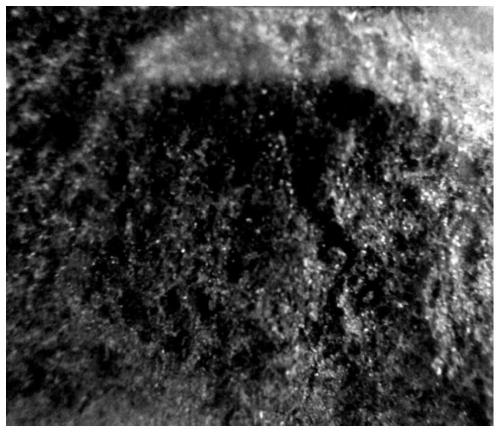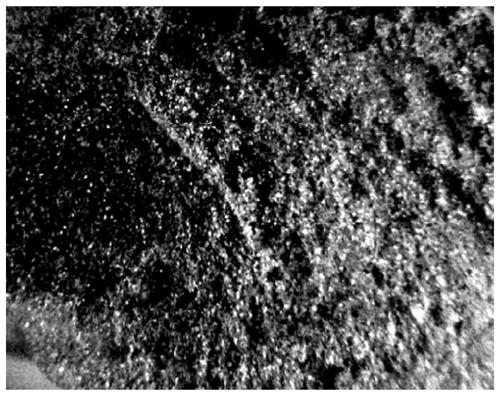Preparation method of particle-reinforced high aluminum silicon based composite material
A composite material and particle-reinforced technology, which is applied in the field of aluminum-silicon alloy materials, can solve the problems of losing heterogeneous cores, coarsening and refining of primary silicon, and achieves improved mechanical properties and wear resistance of alloys, and simple preparation , excellent overall performance
- Summary
- Abstract
- Description
- Claims
- Application Information
AI Technical Summary
Problems solved by technology
Method used
Image
Examples
Embodiment 1
[0027] (1) First prepare materials according to mass percentage: silicon carbide powder and particles accounting for 10% of the total mass of the two, potassium fluotitanate accounting for 20% of the total mass of the two, and mix the above two powders evenly.
[0028] (2) Melt the aluminum-silicon alloy in the furnace, in which silicon accounts for 12%, and after heating up to 820°C, add two mixed powder raw materials that account for the weight ratio of the aluminum melt into the furnace and fully stir the melt to keep it warm for 10 minutes. After removing slag, add phosphorus salt modifier at 820°C, use nitrogen and argon to treat for 15-30 minutes, and cast it into an ingot.
[0029] (3) Melt the ZL109 alloy in the furnace, add 50% silicon carbide reinforcing agent to cast the ingot, add 3% refining agent at 720°C, refine for 10 minutes, add phosphor copper modifier with nitrogen and argon at 820°C Process for 15-30 minutes. Die cast or cast into various products.
[00...
Embodiment 2
[0034] (1) First prepare materials according to mass percentage: silicon carbide powder and particles accounting for 20% of the total mass of the two, potassium fluotitanate accounting for 40% of the total mass of the two, and mix the above two powders evenly.
[0035] (2) Melt the aluminum-silicon alloy in the furnace, in which silicon accounts for 20%, Fe5%, Cu4%, and Mg3% are heated to 1250°C, and then the two mixed powder materials accounting for the weight ratio of the aluminum melt are added to the furnace and fully stirred to melt After the liquid is kept warm for 10 minutes, after removing the slag from the molten liquid, add 3% refining agent at 760°C, refine for 10 minutes, refine, add phosphorus salt modifier at 820°C and treat with argon for 15-30 minutes, die-cast or cast into Various products.
[0036] It has been detected that silicon carbide or diamond components account for 20%.
[0037] For the friction test, the RFT friction testing machine was used, the fr...
Embodiment 3
[0040] (1) at first prepare material by mass percentage: account for the 18% silicon carbide powder 18% diamond powder of both gross mass and particle, account for the 50% potassium fluotitanate of both gross mass, above-mentioned two kinds of powders well mixed.
[0041] (2) Melt the aluminum-silicon alloy in the furnace, in which silicon accounts for 12%, and after heating up to 950°C, add three mixed powder materials accounting for the weight ratio of the aluminum melt into the furnace and fully stir the melt for 10 minutes. After removing the slag, add a phosphorus salt modifier at 820°C and treat with argon for 15-30 minutes, and cast it into an ingot.
[0042] (3) Melt the ADC12 alloy in the furnace, add 30% silicon carbide reinforcing agent to cast the ingot, after melting, add 3% refining agent at 720°C, refine for 10 minutes, add phosphorus salt modifier at 820°C and use nitrogen , argon for 15-30 minutes. Die cast or cast into various products.
[0043] After test...
PUM
| Property | Measurement | Unit |
|---|---|---|
| Tensile strength | aaaaa | aaaaa |
| Tensile strength | aaaaa | aaaaa |
| Tensile strength | aaaaa | aaaaa |
Abstract
Description
Claims
Application Information
 Login to View More
Login to View More - R&D
- Intellectual Property
- Life Sciences
- Materials
- Tech Scout
- Unparalleled Data Quality
- Higher Quality Content
- 60% Fewer Hallucinations
Browse by: Latest US Patents, China's latest patents, Technical Efficacy Thesaurus, Application Domain, Technology Topic, Popular Technical Reports.
© 2025 PatSnap. All rights reserved.Legal|Privacy policy|Modern Slavery Act Transparency Statement|Sitemap|About US| Contact US: help@patsnap.com



